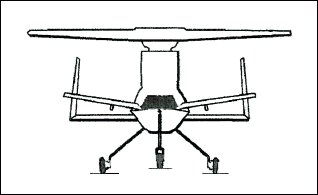The X-50A Canard Rotor/Wing (CR/W) began as a McDonnell Douglas Helicopters project for a VTOL reconnaissance and surveillance UAV in 1992; concept based on NASA-funded studies into high-speed rotorcraft and earlier (Hughes) rotor/wing studies. Design undertaken by Phantom Works personnel at Mesa, Arizona, under a March 1998 DARPA contract calling for the manufacture and testing of two prototypes. US Marine Corps is reported to have expressed interest in a manned version armed with missiles and other weaponry for use in the escort role.
As currently envisaged, it will possess VTOL attributes of the helicopter and the ability to fly like a conventional fixed-wing aircraft, with the addition of foreplanes being a key factor in bestowing this potential. Power will be provided by a single turbofan engine. In helicopter mode, exhaust gases will pass through channels in the two-blade rotor before exiting through vents in the blade tips. In aeroplane mode, as speed increases, exhaust efflux progressively transfers from driving the rotor to a nozzle at the rear, thus providing forward thrust.
With no tail rotor, directional control in helicopter mode will rely on what Boeing calls "reaction drive", in which exhaust gases are diverted to nozzles on both sides of the tail; for aeroplane mode, conventional control surfaces will be provided, although consideration is being given to employing reaction jets for directional control in both modes of flight.
Following vertical take-off as a helicopter, the CR/W will accelerate to about 225km/h before making the transition to aeroplane. This will be accomplished with the assistance of flap surfaces on the foreplanes and the aft-mounted wings. These will increase the amount of lift generated by the wings and reduce rotor loadings, whereupon the rotor will be slowed to a stop before being locked in position across the fuselage to act as an extra lifting surface. The flaps will then be retracted, with the three lifting surfaces sharing the load. For landing, the process will be reversed, enabling the CR/W to operate safely from confined areas, such as a carrier deck or helicopter platform. In conventional aeroplane mode, maximum speed is predicted to exceed 695km/h.
Initial research to include studies into ways and means of using exhaust gases to perform multiple functions, with US$21 million allocated jointly by Boeing and DARPA to pay for a three-year research effort. Boeing's Mesa facility is leading the project and had responsibility for assembly; further support provided by Boeing sites in Philadelphia and St Louis.
Initial technology demonstrator to be a subscale, unmanned aerial vehicle (UAV); first X-50A prototype was to have flown in 2001, but postponed; roll-out May 2002; maiden flight expected in mid-2003, following discovery of high cyclic loads during ground testing that necessitated repairs to rotor bearings as well as adoption of a modified swashplate design and use of steel instead of aluminium for greater stiffness. Total of 11 flights planned in three months, with test vehicle not to exceed 278km/h. X-50A will take-off vertically and operate as helicopter up to 111km/h, when canard and stabiliser begin to provide lift; transition to conventional wing-borne flight will occur at 241km/h. X-50A prototype is powered by a 3.11kN Williams F112 turbofan. Any subsequent production CR/W is likely to use advanced composites materials and be built in both manned and unmanned versions; Boeing studies include a 1,100kg maritime UAV and a 10,000 to 11,000kg manned aircraft that could function as an armed escort fighter in support of the MV-22B Osprey.
Jane's All the World's Aircraft, 2004-2005





